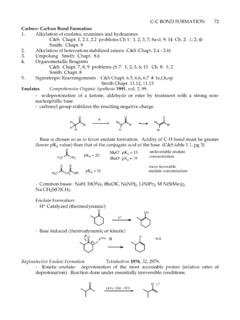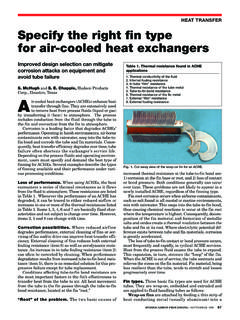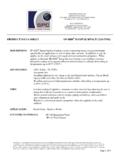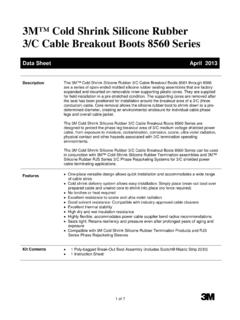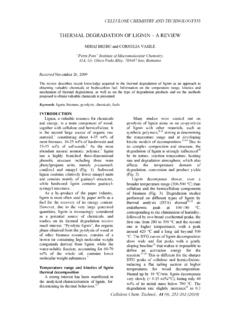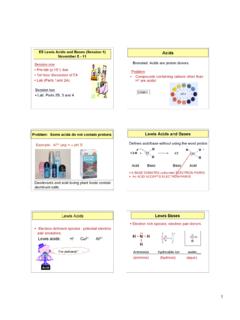Transcription of How Tc can go above 100 K in the YBCO family
1 Eur. Phys. J. B (2009) ArticleTHEEUROPEANPHYSICALJOURNALBHow Tccan go above 100 K in the YBCO familyA. Tavana1,2and M. Akhavan1,a1 Magnet Research Laboratory (MRL), Department of Physics, Sharif University of Technology, Box 11365-9161,Tehran, Iran2 Department of Physics, University of Mohaghegh Ardabili, Ardabil, IranReceived 21 June 2009 / Received in final form 31 August 2009 Published online 25 November 2009 c EDP Sciences, Societ`a Italiana di Fisica, Springer-Verlag report the results of the electronic structure calculation of a newly discovered member ofthe YBCO high-Tcfamily, , Y3Ba5Cu8O18(Y358) withTc>100, based on the full-potential linearizedaugmented plane waves method (FP-LAPW) of density functional theory in the generalized gradientapproximation (GGA). The evolution of the number of hole carriers in different sites of the CuO2planesand CuO chains has been investigated in comparison with the other YBCO family members, , Y123,Pr123, Y124, and Y247.
2 The results suggest that pumping hole carriers out of the chains toward the planesenhances the transition temperature. The band structure calculations have been performed for Y358, andthe results show similar features with the other family members. Most notably, a van Hove singularityforms near the X point of the Brillouin zone below the Fermi level and within the energy of the bucklingphonon mode, for which the interplay is Density functional theory, local density approximation, gradient and other corrections Electron density of states and band structure of crystalline solids Cuprate supercon-ductors (high-Tcand insulating parent compounds)1 IntroductionYBa2Cu3O7(Y123) is the first superconductor discoveredwith the transition temperature above the liquid nitro-gen boiling temperature [1]. This compound has been aninteresting subject for much research and yet scientistsare hopeful to find better superconducting compoundswith similar composition.
3 There is no real change in thesuperconductivity of Y123 when the Y atom is substi-tuted by other trivalent rare earths elements except for Pr,by which superconductivity suppresses [2]. YBa2Cu4O16(Y124) and Y2Ba4Cu7O15(Y247) are other two familiarmembers of the YBCO- family , but with lower transitiontemperatures: 84 K [3]and65K[4], respectively. Like theother high-Tccuprate superconductors, the most impor-tant element of this family is the CuO2planes, in whichthe electrons the YBCO family , like in the other cuprates, theTcand the Cu-O-Cu bond buckling angle of the CuO2plane are correlated, and both go through a maximumwith doping, but in the YBCO family the optimum buck-ling angle is larger than in the other cuprates [5]. Thisis also an implication of the important role of the out-of-plane buckling phonon mode of the oxygen atoms in thecuprates.
4 The other distinctive structural elements of are formation of the CuO chains and double-chains(two neighboring chains displaced parallel to each otherby half lattice parameter). In this family the chains arebelieved to play the role of the carrier reservoirs with mi-nor contribution to the conductivity of the system; anddoping of the carriers occurs by pumping oxygen into thechains. Y123 has two CuO2planes and one chain, wheretwo planes are symmetrically equivalent. Y124 has one in-equivalent plane and one double-chain, and Y247 has twoinequivalent planes, one chain, and one enhancement ofTcunder applying pressure onY123 [6] suggests that we may yet improveTcat ambientpressure in the YBCO family by either chemical substi-tutions or structural deformations. A new member of theYBCO family has been reported with transition temper-ature above 100 K [7].
5 We have synthesized and charac-terized a few samples of a new YBCO compound by thesolid-state reaction method withTcabout 102 116 K (dif-ferentTcvalues are for different synthesis conditions) [8].The chemical formula of this compound is Y3Ba5Cu8O18(Y358) with the crystal structure as depicted in compound is synthesized with similar simple proce-dure but cheaper than Y123, and is potentially a betterchoice for the industrial and large scale applications. Y358has five CuO2planes and three single chains which are re-spectively labeled as planes I to V and chains I to III inFigure1; one of the planes, , the plane III, has no apical2 The European Physical Journal BFig. 1.(Color online) Crystal structure of Y358 with fiveCuO2planes I to V and three CuO chains I to atoms. It has been claimed that the maximumTcin each cuprate family belongs to the member with threeCuO2planes [9], but the reason is not clear.
6 In Y358 infact, we have two groups of successive CuO2planes whichare separated by the insulating layers, a two-plane groupand a three-plane group. So, the situation is somehow dif-ferent from the original cuprates where all the CuO2layersare in succession. Different proposals can be examined forthis new compound which has higherTcwith five copperoxide electron-phonon interaction and strong electroncorrelations are two main candidates for the origin ofthe mechanism of high-Tcsuperconductivity concentration in the copper oxide planes plays animportant role in every theory of superconductivity, so,studying the evolution of thecarriers in different sitesof the high-Tcsuperconductors versus doping or struc-tural deformations, etc. may help to better justification ofany mechanism candidate for HTSC. Of course, the wellknown dome-shapedTcversus doping and many otherparameters is almost always applicable for cuprates, butthe problem is that in some compounds one really hasno knowledge of the actual relation between the amountof chemical doping with the actual doped carriers in theplanes or other sites of that compound.
7 This is the case forthe YBCO family in which it is not clear how the numberof carriers in the planes and the chains change with theoxygen this paper, we will consider the answer to the abovequestion for different YBCO family members, , com-pare the doped hole carriers in different sites of the planesand chains in all member compounds. We will also presentthe results of a density functional theory (DFT) study onthe hole concentration in the planes and the chains of dif-ferent members of the YBCO family . Also, we will presentfor the first time the results of the band structure calcula-tions of the Y358 compound and investigate the couplingof a near Fermi level van Hove singularity (VHS) with thebuckling phonon mode of the oxygen atoms in Y358. This,we hope would stimulate the search for higher supercon-ducting transition temperatures in the Y-based cupratesas well as in the other Computational detailsAll the calculations are performed utilizing the WIEN code which is a powerful full potential DFT code [10].
8 Theemployed basis set is the linearized augmented plane wavesto which the local orbitals can be added (LAPW+lo).However, though using DFT is not very suitable whenstudying the strongly correlated materials like the high-Tccuprate superconductors, but this is the only available ab-initio approach which could efficiently be used when weaim to study the differences between some similar struc-tures and their effects on the superconducting state. Ap-plicability of the DFT approach to the cuprate supercon-ductivity was settled after the experimental data showedgood agreement with the computational results. For ex-ample, the experimental structural parameters and Fermisurfaces [11], and also the calculated phonon modes [12,13]are in very good agreement with the experiment. Any-way, DFT can be used as a starting point before one per-forms a strongly correlated calculation, as most of the ini-tial parameters of the strongly correlated models such asHubbard U, hopping integrals, carrier concentration, be obtained within structural parameters of Y123, Y124, and Y247have been set from the experiment [14 16], and for Y358we have used the data from the X-ray diffraction analysisof our own samples [8].
9 For Pr123 we have used the pa-rameters of Y123 for better comparison. The muffin tinradii have been set equal to , , , , and the Y, Pr, Ba, Cu, and O atoms, respectively. Thesevalues were kept unchanged in all calculations which en-abled us to compare the charge inside every muffin tinsphere relative to similar atomic spheres in other com-pounds. The GGA has been used for the exchange andcorrelation functional. The energy separation between thecore and valence states has been set equal to Ry. TheAPW+lo basis set has been selected for thedorbitals ofA. Tavana and M. Akhavan: HowTccangoabove100 KintheYBCO family3the Cu atoms and for theforbitals of the Pr atom to havea more effective convergence. For all other atomic orbitals,we have used the LAPW basis set. The RKmax,Lmax,andGmaxparameters have been set equal to , 10, and 14,respectively.
10 In addition to the energy convergence, thecharges have also been converged. The number of k pointssampled in the first Brillion zone has been set equal to500, 500, 300, 200, and 200 for Y123, Pr123, Y124, Y247,and Y358, Results and Carriers in the planes and the chainsThe theoretical models for superconductivity often usethe hole concentration in the CuO2planes as their inputparameter. In some high-Tcsuperconductors like La1 x(Sr or Ba)xCu2O4this quantity has a direct relation withdoping. But, usually, determination of the actual amountof the hole content is not easy or straightforward. An im-portant case is the 66 K plateau in theTcversus dopingdiagram of Y123. The reason for this plateau is not ob-vious, but it is usually being ascribed to that the holeconcentration remains constant in the planes when theoxygen content changes to , due to rearrange-ment of the oxygen atoms in the basal planes (chains) [17].
